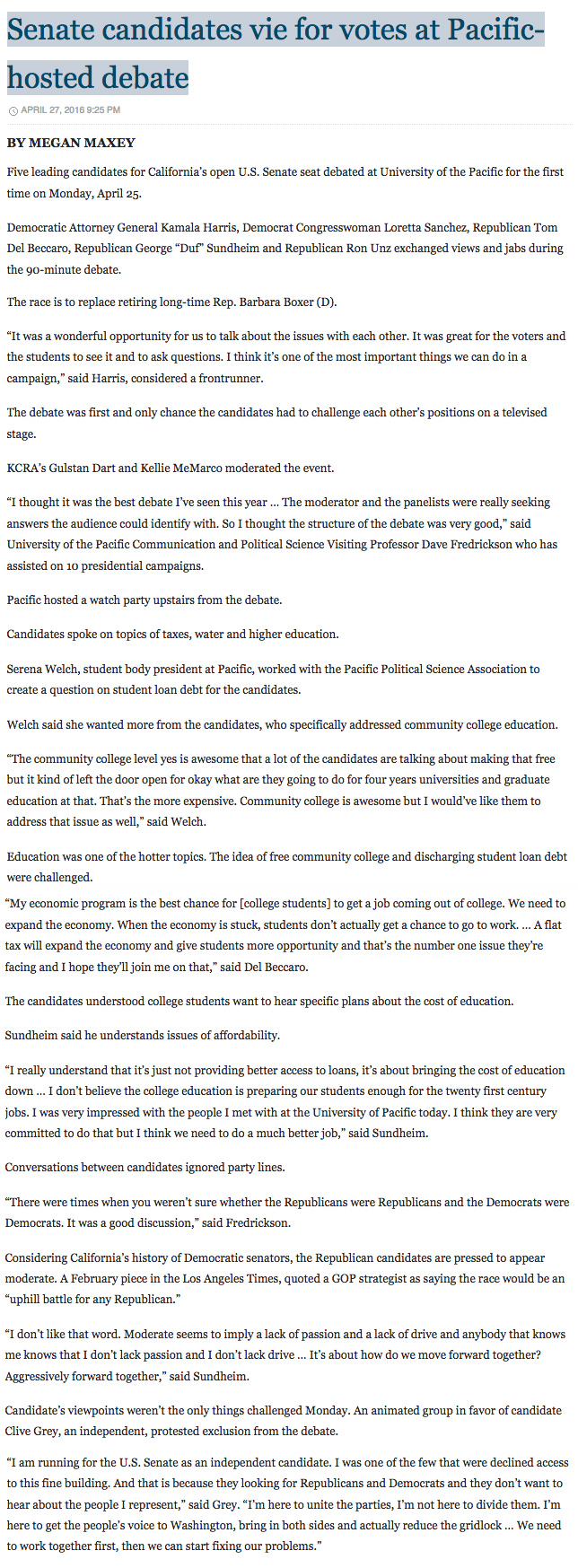Hover over the green markers to find out about different areas in this online-only news story published in Spring 2016.
Headline
Editors are responsible for writing headlines on the Collegian staff. You may make a suggestion and have a consultation with the editor. Be aware that headlines must contain a verb and attempt to relay story content in as few words as possible.
Byline
Stories reflect the byline of the author, unless the story is an unsigned editorial that is meant to reflect the opinion of the staff. Unsigned editorials are typically composed by a member of the editing team in MCOM 12.
Lede
The first sentence of your story should grab your reader's attention. It should focus on either the who, what, where, when, why and/or how. It is up to you to determine which element will grab the most reader attention.
Short, declarative statements
Avoid long, jargon-laden sentences. Keep it simple. This sentence moves the story along without crowding it.
Direct quote
Quotes are often the best way to avoid adding your personal opinion in a story. Instead, bring in another person's thoughts and opinions. Here the writer quoted Kamala Harris, who was considered the front runner going into the debate. The Harris quote is important because it shows the writer did some research and knows who readers will be expecting to hear from.
Scope
What makes this story special/unique? Why is this story being reported? This scope of this story was that it was the first and only time these candidates would face off. There were no other planned debates, bringing it to a role of importance.
Additional detail
Name recognition here is huge. This is, again, a subtle detail that will help the reader along and give them some familiarity.
Direct quote #2
This quote is from a University of the Pacific professor who has been involved in presidential campaigns. It provides his credentials at the end. Notice how he elaborates on the topic through a quote instead of having the writer do it.
Transition
These next few grafs are leading up to the quote from the University of the Pacific student, who mentions that she wanted to hear more about how the candidates would help college students similar to her, not just community college students. The author included the quote because Delta College is a community college. These remarks directly impacted our student body.
Direct quote #3
Quote from University of the Pacific student to support what was mentioned in transitional area above.
Transition
Again the use of a transitional statement to set up the the quote. Notice how there is no quote lead in here. The quote stands on its own. Best practices would have all stories have quotes that stand on their own without the crutch of a lead in. It makes the story easier to digest for a busy reader.
Direct quote #4
A quote regarding community college education directly from a candidate. The author knew her audience. She included this quote over others from more prominent candidates because it spoke to an area of concern among her peers.
Transition
The author moves the story along by introducing another candidate through a transitional statement, still tied to the community college interest.
Direct quote #5
A quote from another candidate with comment about education. This statement ties into the quotes about college funding, but also branches off a little to show more area of analysis.
Transition
A statement to set up a deeper analysis of the debate.
Direct quote #6
Analysis by a previously introduced source, moves the story along without bogging it down.
Additional context
In inverted pyramid, you should be able to cut the bottom in order to make a story shorter. As the author got to this point, she understood her readers would start to lose some steam. Here she provides context to move readers along, but knows that in the end it may get chopped.
Direct quote #7
Addresses the context mentioned previously. Transitions will act as a bridge between supporting quotes.
Wrap up
The author addresses outside influences. She noticed protestors on campus and asked them questions. The story here was the debate, but this was an interesting and fair bit of information to add in. This debate was not without it's criticism. The author is sure to note that.
